
Welcome to the only platform where you can connect with MASLD/MASH experts in your geographic area and stay up to date with disease state education in the form of short video modules and news articles.
Thought Leader
Mission of the MASLD Community
Dedicated to fostering collaboration, driving innovation, and improving outcomes for patients living with Metabolic Associated Steatotic Liver Disease.


Engage with MASLD/MASH Experts in Your Region
Connect with regional specialists for personalized guidance, professional training, and continuous support in MASLD/MASH.


Expert Insights
Benefit from expert-driven resources, including podcasts, publications, and practical tools designed for clinicians and patients.


Tailored Education for Your Community
Join your regional community network, where education is tailored to meet local needs. Collaborate with peers from local and regional communities, share knowledge, and drive impactful changes together.
Featured MASLD/MASH Educators

Erin Parkinson
MS, SPRN, FNP-C
Erin Parkinson has been a board-certified family nurse practitioner since 2007 and has been practicing in Transplant and Non-transplant Hepatology with the Tampa General Medical Group since 2011. She is the Lead Advanced Practice Provider for the Hepatology program. She has presented at national and regional meetings and is the author of multiple abstracts and poster presentations. She serves as a sub investigator for multiple clinical trials within hepatology and conducts her own research surrounding APP led practice initiatives and hepatitis C. She is a member of the AASLD annual meeting education committee and was a mentor for the ELAPP program with AASLD. She resides in St. Petersburg Florida with her husband and two sons.

Christina Hanson
FNP-C
Christina Hanson, FNP-C, is a Family Nurse Practitioner at South Denver Gastroenterology in Colorado, specializing in gastrointestinal and liver diseases. She is also a board member of GHAPP and an active educator for healthcare providers.
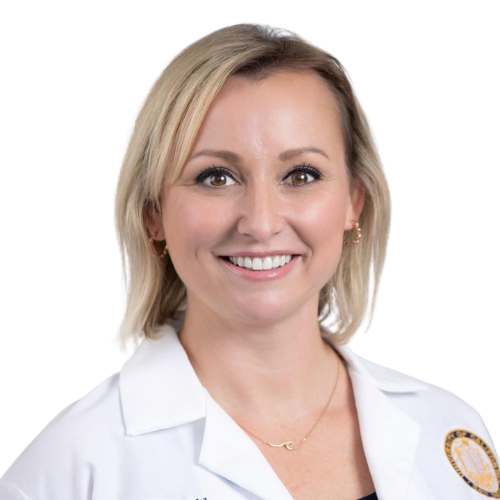
Summer Collier
MSN, FNP-BC
Summer Collier is a board-certified family nurse practitioner specializing in hepatology at UC San Diego Health. She provides comprehensive care for patients with chronic liver diseases, including viral hepatitis B and C, autoimmune liver diseases, and alcohol-associated liver disease. Summer earned her Master of Science in Nursing and holds certifications as a Family Nurse Practitioner (FNP-BC) and HIV Specialist (AAHIVS). She is actively involved in advancing liver health through her clinical practice and community initiatives. Committed to patient-centered care, Summer integrates her clinical expertise with a compassionate approach, aiming to improve the quality of life for individuals affected by liver diseases.

Kate Lee-Young
CRNP, DNP
Kate Lee Young, CRNP, DNP, is a gastroenterology nurse practitioner at Johns Hopkins Green Spring Station, providing specialized care for patients with digestive health needs. Board-certified in Adult-Gerontology Primary Care, she is focused on delivering comprehensive and patient-centered care.

Lucy Matthew
NP
Lucy Mathew, NP, is a nurse practitioner at Cedars-Sinai Medical Center, specializing in providing expert care for patients with complex medical conditions. With a focus on personalized treatment and patient education, she is dedicated to improving health outcomes through evidence-based practices.

Gabriella McCarty
NP-C
Gabriella McCarty is a gastroenterology/hepatology nurse practitioner. She obtained her masters and nurse practitioner degree at Case Western Reserve University in 2004. She has been practicing in this field for 26 years. She serves as faculty for Gastroenterology/ Hepatology Advanced Practice Providers (GHAPP) and is an American College of Gastroenterology (ACG) committee member, serving on the education subcommittee. She will be completing her doctorate of nursing in May 2025. She loves all aspects of GI / Hepatology, education and nursing.

Alison Moe
PA-C
Alison S. Moe, MS, PA-C, is a board-certified physician assistant specializing in gastroenterology at United Digestive's Braselton office in Hoschton, Georgia. She earned her Master of Science in Medical Education from Seton Hall University and a Bachelor of Arts in Physical Anthropology from the State University of New York at Stony Brook. Alison is fluent in Spanish and has a special interest in treating irritable bowel syndrome and liver disease. With almost two decades of experience as a Physician Assistant, Alison has developed a strong foundation in both clinical practice and research, particularly in the fields of gastroenterology and hepatology. Alison's dedication to patient care includes extensive clinical hours, allowing her to cultivate deep relationships with patients as well as national experts caring for individuals, especially those suffering from inflammatory bowel disease (IBD) and advanced liver disease. Alison's commitment to advancing the understanding and treatment of these conditions drives my clinical practice and ongoing research efforts, aiming to provide the highest standard of care for my patients.

Christie Morrison
AGACNP-BC
Christie Morrison, AGACNP-BC, is a nurse practitioner at Oshi Health, specializing in virtual GI care and managing a team of GI providers. With extensive experience in inflammatory bowel disease, she also works part-time at Texas Digestive Disease Center in San Antonio.

Jill Olmstead
DNP, ANP-BC, FAANP
Jill Olmstead, ANP, MSN, is a gastroenterology nurse practitioner with Providence St. Jude Heritage Medical Group in Fullerton, California. She specializes in diagnosing and managing gastrointestinal disorders, offering compassionate, evidence-based care to improve patient outcomes.

Oyin Penny
MSN, FNP
Oyin Penny is a dedicated and experienced Nurse practitioner in Hepatology and Gastroenterology with a passion for providing comprehensive care to patients with various gastrointestinal disorders and liver disease. Oyin has 13+ years of clinical experience. She has an expertise in managing patients in conditions such as Steatotic liver disease (metabolic liver disease), chronic liver disease, hepatitis (acute or chronic), inflammatory bowel disease and functional GI disorders in both inpatient and outpatient settings. She actively collaborates with multidisciplinary teams to ensure her patients receive the best quality care. Oyin is committed to a patient-centered care, with emphasis on education, disease prevention, and lifestyle modifications to improve health outcomes. In addition to clinical experience, Oyin is passionate about patient advocacy and mentorship. She is currently a Mentor for APPs for the ACG and also initiated and leads the KC Gut club for APPs in GI and Hepatology in the Kansas City area.

Emily Przybyl
PA-C
Emily Przybyl is a certified physician assistant in ECMC’s Center for Hepatology Care and in ECMC’s Center for Gastroenterology Care. She cares for patients with conditions involving the liver and gastrointestinal tract. Previously, Emily Przybyl worked as a hospitalist at Buffalo General Medical Center, where she performed admissions and evaluated and managed acute issues overnight. She has experience in internal medicine and gastroenterology.

Lisa Richards
MSN, FNP-BC, AF-AASLD
Lisa Richards, MSN, is a board-certified family nurse practitioner (FNP-BC) who provides care for hepatology patients with a variety of liver diagnoses. She specializes in metabolic dysfunction steatotic liver disease (MASLD) with Dr. Rohit Loomba. Ms. Richards has over 20 years of experience as a hepatology nurse practitioner and has worked with Dr. Loomba since 2009.

Sharon Rimon
NP
During her dozen years at AZ Gastro Care, Sharon has responsibilities for both patient care and administration, seeing all types of gastroenterology patients and overseeing tasks such as credentialing, staffing, and contracting. Her clinical passion is Inflammatory Bowel Disease and she spends much of her time educating, treating, and enhancing patient outcomes. Patient advocacy is another strength that she brings to the table, making sure that the patient’s quality of life is addressed. She brings with her a wide range of nursing experience including home health, inpatient telemetry, and critical care and nursing director.

Jordan Mayberry
MPAS, PA-C
Jordan Mayberry, M.P.A.S., PA-C, is a board-certified physician assistant specializing in internal medicine with a focus on digestive and liver diseases at UT Southwestern Medical Center in Dallas, Texas. She earned her Master of Physician Assistant Studies and has over a decade of experience in hepatology. Jordan is dedicated to providing comprehensive care for patients with liver conditions.

Carla Molliner
PA-C
Carla M. Molliner, MMS, PA-C, is a board-certified physician assistant specializing in hepatology at the University of Miami's Hepatology Division. Carla is actively involved in professional organizations, serving as a faculty advisor for GHAPP. She is dedicated to providing comprehensive care for patients with liver diseases.

Anne Moore
NP
Ann Moore is a hepatology nurse practitioner and VP of Clinical Services at Arizona Liver Health. She has over 30 years of liver disease and liver transplant management experience and is recognized nationally for her liver disease expertise. In addition to her clinical practice, she serves as Principal Investigator for multiple clinical trials in MASH and other liver diseases. Throughout her career, Ann has worked to expand access to liver disease care throughout the state of Arizona, running numerous outreach clinics in rural locations.

April Morris
FNP
April Morris, FNP, is a board-certified Family Nurse Practitioner at Hunter Holmes McGuire VA Medical Center in Richmond, Virginia. She specializes in gastroenterology and hepatology, focusing on developing a metabolic liver clinic for patients with nonalcoholic steatohepatitis (NASH).

Janet Gripshover
DNP, MBA
Janet Gripshover, DNP,MBA, is the Nurse Manager for UCLA’s Liver and Small Bowel Transplant program. She specializes in hepatology and transplant medicine, overseeing patient care and program operations for individuals undergoing liver and small bowel transplants.

Milly Ng
FNP, MPH
Miu Lai "Milly" Ng FNP-BC, MPH is a dedicated Nurse Practitioner specializing in hepatology at Tufts Medical Center, with 8 years of experience in managing patients with Metabolic Dysfunction-Associated Steatotic Liver Disease (MASLD) and Metabolic Dysfunction-Associated Steatohepatitis (MASH), including the lean MASH population. Passionate about improving liver health within the Asian population, Miu Lai is actively engaged in community outreach and education. Their clinical expertise includes the use of GLP-1 receptor agonists and liver-targeted medications to optimize treatment outcomes. In addition to clinical practice, Miu Lai serves as a consultant for Pharmaceuticals and contributes expertise to multiple advisory boards and podcasts, advocating for advancements in hepatology care.

Michelle Barnett
PA-C, MPAS, DFAAPA
Michelle Barnett is a highly experienced physician assistant specializing in gastroenterology at Peak Gastroenterology Associates in Colorado Springs, Colorado. With over 30 years in the GI and liver communities, she has held leadership roles, including serving as President of the Colorado Academy of Physician Assistants (CAPA) and receiving CAPA's Physician Assistant of the Year award. A graduate of Wichita State University and the University of Nebraska, Michelle has been recognized with the DFAAPA distinction and honors such as the Crohn’s and Colitis Foundation's IBD internship and the International Foundation for Gastrointestinal Disorders Ally Award. Passionate about holistic care, she incorporates lifestyle strategies like nutrition, yoga, and meditation into her practice. Outside of work, Michelle enjoys hiking, musical theater, and supporting her favorite Colorado sports teams.

Erin Parkinson
MS, SPRN, FNP-C
Erin Parkinson has been a board-certified family nurse practitioner since 2007 and has been practicing in Transplant and Non-transplant Hepatology with the Tampa General Medical Group since 2011. She is the Lead Advanced Practice Provider for the Hepatology program. She has presented at national and regional meetings and is the author of multiple abstracts and poster presentations. She serves as a sub investigator for multiple clinical trials within hepatology and conducts her own research surrounding APP led practice initiatives and hepatitis C. She is a member of the AASLD annual meeting education committee and was a mentor for the ELAPP program with AASLD. She resides in St. Petersburg Florida with her husband and two sons.

Christina Hanson
FNP-C
Christina Hanson, FNP-C, is a Family Nurse Practitioner at South Denver Gastroenterology in Colorado, specializing in gastrointestinal and liver diseases. She is also a board member of GHAPP and an active educator for healthcare providers.

Summer Collier
MSN, FNP-BC
Summer Collier is a board-certified family nurse practitioner specializing in hepatology at UC San Diego Health. She provides comprehensive care for patients with chronic liver diseases, including viral hepatitis B and C, autoimmune liver diseases, and alcohol-associated liver disease. Summer earned her Master of Science in Nursing and holds certifications as a Family Nurse Practitioner (FNP-BC) and HIV Specialist (AAHIVS). She is actively involved in advancing liver health through her clinical practice and community initiatives. Committed to patient-centered care, Summer integrates her clinical expertise with a compassionate approach, aiming to improve the quality of life for individuals affected by liver diseases.

Kate Lee-Young
CRNP, DNP
Kate Lee Young, CRNP, DNP, is a gastroenterology nurse practitioner at Johns Hopkins Green Spring Station, providing specialized care for patients with digestive health needs. Board-certified in Adult-Gerontology Primary Care, she is focused on delivering comprehensive and patient-centered care.

Lucy Matthew
NP
Lucy Mathew, NP, is a nurse practitioner at Cedars-Sinai Medical Center, specializing in providing expert care for patients with complex medical conditions. With a focus on personalized treatment and patient education, she is dedicated to improving health outcomes through evidence-based practices.

Gabriella McCarty
NP-C
Gabriella McCarty is a gastroenterology/hepatology nurse practitioner. She obtained her masters and nurse practitioner degree at Case Western Reserve University in 2004. She has been practicing in this field for 26 years. She serves as faculty for Gastroenterology/ Hepatology Advanced Practice Providers (GHAPP) and is an American College of Gastroenterology (ACG) committee member, serving on the education subcommittee. She will be completing her doctorate of nursing in May 2025. She loves all aspects of GI / Hepatology, education and nursing.

Alison Moe
PA-C
Alison S. Moe, MS, PA-C, is a board-certified physician assistant specializing in gastroenterology at United Digestive's Braselton office in Hoschton, Georgia. She earned her Master of Science in Medical Education from Seton Hall University and a Bachelor of Arts in Physical Anthropology from the State University of New York at Stony Brook. Alison is fluent in Spanish and has a special interest in treating irritable bowel syndrome and liver disease. With almost two decades of experience as a Physician Assistant, Alison has developed a strong foundation in both clinical practice and research, particularly in the fields of gastroenterology and hepatology. Alison's dedication to patient care includes extensive clinical hours, allowing her to cultivate deep relationships with patients as well as national experts caring for individuals, especially those suffering from inflammatory bowel disease (IBD) and advanced liver disease. Alison's commitment to advancing the understanding and treatment of these conditions drives my clinical practice and ongoing research efforts, aiming to provide the highest standard of care for my patients.

Christie Morrison
AGACNP-BC
Christie Morrison, AGACNP-BC, is a nurse practitioner at Oshi Health, specializing in virtual GI care and managing a team of GI providers. With extensive experience in inflammatory bowel disease, she also works part-time at Texas Digestive Disease Center in San Antonio.

Jill Olmstead
DNP, ANP-BC, FAANP
Jill Olmstead, ANP, MSN, is a gastroenterology nurse practitioner with Providence St. Jude Heritage Medical Group in Fullerton, California. She specializes in diagnosing and managing gastrointestinal disorders, offering compassionate, evidence-based care to improve patient outcomes.

Oyin Penny
MSN, FNP
Oyin Penny is a dedicated and experienced Nurse practitioner in Hepatology and Gastroenterology with a passion for providing comprehensive care to patients with various gastrointestinal disorders and liver disease. Oyin has 13+ years of clinical experience. She has an expertise in managing patients in conditions such as Steatotic liver disease (metabolic liver disease), chronic liver disease, hepatitis (acute or chronic), inflammatory bowel disease and functional GI disorders in both inpatient and outpatient settings. She actively collaborates with multidisciplinary teams to ensure her patients receive the best quality care. Oyin is committed to a patient-centered care, with emphasis on education, disease prevention, and lifestyle modifications to improve health outcomes. In addition to clinical experience, Oyin is passionate about patient advocacy and mentorship. She is currently a Mentor for APPs for the ACG and also initiated and leads the KC Gut club for APPs in GI and Hepatology in the Kansas City area.

Emily Przybyl
PA-C
Emily Przybyl is a certified physician assistant in ECMC’s Center for Hepatology Care and in ECMC’s Center for Gastroenterology Care. She cares for patients with conditions involving the liver and gastrointestinal tract. Previously, Emily Przybyl worked as a hospitalist at Buffalo General Medical Center, where she performed admissions and evaluated and managed acute issues overnight. She has experience in internal medicine and gastroenterology.

Lisa Richards
MSN, FNP-BC, AF-AASLD
Lisa Richards, MSN, is a board-certified family nurse practitioner (FNP-BC) who provides care for hepatology patients with a variety of liver diagnoses. She specializes in metabolic dysfunction steatotic liver disease (MASLD) with Dr. Rohit Loomba. Ms. Richards has over 20 years of experience as a hepatology nurse practitioner and has worked with Dr. Loomba since 2009.

Sharon Rimon
NP
During her dozen years at AZ Gastro Care, Sharon has responsibilities for both patient care and administration, seeing all types of gastroenterology patients and overseeing tasks such as credentialing, staffing, and contracting. Her clinical passion is Inflammatory Bowel Disease and she spends much of her time educating, treating, and enhancing patient outcomes. Patient advocacy is another strength that she brings to the table, making sure that the patient’s quality of life is addressed. She brings with her a wide range of nursing experience including home health, inpatient telemetry, and critical care and nursing director.

Jordan Mayberry
MPAS, PA-C
Jordan Mayberry, M.P.A.S., PA-C, is a board-certified physician assistant specializing in internal medicine with a focus on digestive and liver diseases at UT Southwestern Medical Center in Dallas, Texas. She earned her Master of Physician Assistant Studies and has over a decade of experience in hepatology. Jordan is dedicated to providing comprehensive care for patients with liver conditions.

Carla Molliner
PA-C
Carla M. Molliner, MMS, PA-C, is a board-certified physician assistant specializing in hepatology at the University of Miami's Hepatology Division. Carla is actively involved in professional organizations, serving as a faculty advisor for GHAPP. She is dedicated to providing comprehensive care for patients with liver diseases.

Anne Moore
NP
Ann Moore is a hepatology nurse practitioner and VP of Clinical Services at Arizona Liver Health. She has over 30 years of liver disease and liver transplant management experience and is recognized nationally for her liver disease expertise. In addition to her clinical practice, she serves as Principal Investigator for multiple clinical trials in MASH and other liver diseases. Throughout her career, Ann has worked to expand access to liver disease care throughout the state of Arizona, running numerous outreach clinics in rural locations.

April Morris
FNP
April Morris, FNP, is a board-certified Family Nurse Practitioner at Hunter Holmes McGuire VA Medical Center in Richmond, Virginia. She specializes in gastroenterology and hepatology, focusing on developing a metabolic liver clinic for patients with nonalcoholic steatohepatitis (NASH).

Janet Gripshover
DNP, MBA
Janet Gripshover, DNP,MBA, is the Nurse Manager for UCLA’s Liver and Small Bowel Transplant program. She specializes in hepatology and transplant medicine, overseeing patient care and program operations for individuals undergoing liver and small bowel transplants.

Milly Ng
FNP, MPH
Miu Lai "Milly" Ng FNP-BC, MPH is a dedicated Nurse Practitioner specializing in hepatology at Tufts Medical Center, with 8 years of experience in managing patients with Metabolic Dysfunction-Associated Steatotic Liver Disease (MASLD) and Metabolic Dysfunction-Associated Steatohepatitis (MASH), including the lean MASH population. Passionate about improving liver health within the Asian population, Miu Lai is actively engaged in community outreach and education. Their clinical expertise includes the use of GLP-1 receptor agonists and liver-targeted medications to optimize treatment outcomes. In addition to clinical practice, Miu Lai serves as a consultant for Pharmaceuticals and contributes expertise to multiple advisory boards and podcasts, advocating for advancements in hepatology care.

Michelle Barnett
PA-C, MPAS, DFAAPA
Michelle Barnett is a highly experienced physician assistant specializing in gastroenterology at Peak Gastroenterology Associates in Colorado Springs, Colorado. With over 30 years in the GI and liver communities, she has held leadership roles, including serving as President of the Colorado Academy of Physician Assistants (CAPA) and receiving CAPA's Physician Assistant of the Year award. A graduate of Wichita State University and the University of Nebraska, Michelle has been recognized with the DFAAPA distinction and honors such as the Crohn’s and Colitis Foundation's IBD internship and the International Foundation for Gastrointestinal Disorders Ally Award. Passionate about holistic care, she incorporates lifestyle strategies like nutrition, yoga, and meditation into her practice. Outside of work, Michelle enjoys hiking, musical theater, and supporting her favorite Colorado sports teams.

Erin Parkinson
MS, SPRN, FNP-C
Erin Parkinson has been a board-certified family nurse practitioner since 2007 and has been practicing in Transplant and Non-transplant Hepatology with the Tampa General Medical Group since 2011. She is the Lead Advanced Practice Provider for the Hepatology program. She has presented at national and regional meetings and is the author of multiple abstracts and poster presentations. She serves as a sub investigator for multiple clinical trials within hepatology and conducts her own research surrounding APP led practice initiatives and hepatitis C. She is a member of the AASLD annual meeting education committee and was a mentor for the ELAPP program with AASLD. She resides in St. Petersburg Florida with her husband and two sons.

Christina Hanson
FNP-C
Christina Hanson, FNP-C, is a Family Nurse Practitioner at South Denver Gastroenterology in Colorado, specializing in gastrointestinal and liver diseases. She is also a board member of GHAPP and an active educator for healthcare providers.

Summer Collier
MSN, FNP-BC
Summer Collier is a board-certified family nurse practitioner specializing in hepatology at UC San Diego Health. She provides comprehensive care for patients with chronic liver diseases, including viral hepatitis B and C, autoimmune liver diseases, and alcohol-associated liver disease. Summer earned her Master of Science in Nursing and holds certifications as a Family Nurse Practitioner (FNP-BC) and HIV Specialist (AAHIVS). She is actively involved in advancing liver health through her clinical practice and community initiatives. Committed to patient-centered care, Summer integrates her clinical expertise with a compassionate approach, aiming to improve the quality of life for individuals affected by liver diseases.
Explore Our Events

Glide Conference

The Greater Long Island Digestive Education (GLIDE) Conference will deliver focused educational updates highlighting clinically relevant advances in t..

GHAPP Eighth Annual Conference

About the 2025 GHAPP Conference The GHAPP conference is the only conference specifically designed by advanced practice providers (APPs) for the pur..
Explore Our Events

CME EVENT
GHAPP Eighth Annual Conference
 September 04 @ 12:00 pm - 12:00 pm MDT
September 04 @ 12:00 pm - 12:00 pm MDT
About the 2025 GHAPP Conference The GHAPP conference is the only conference specifically designed by advanced practice providers (APPs) for the pur..
MASLD/MASH Learning Center
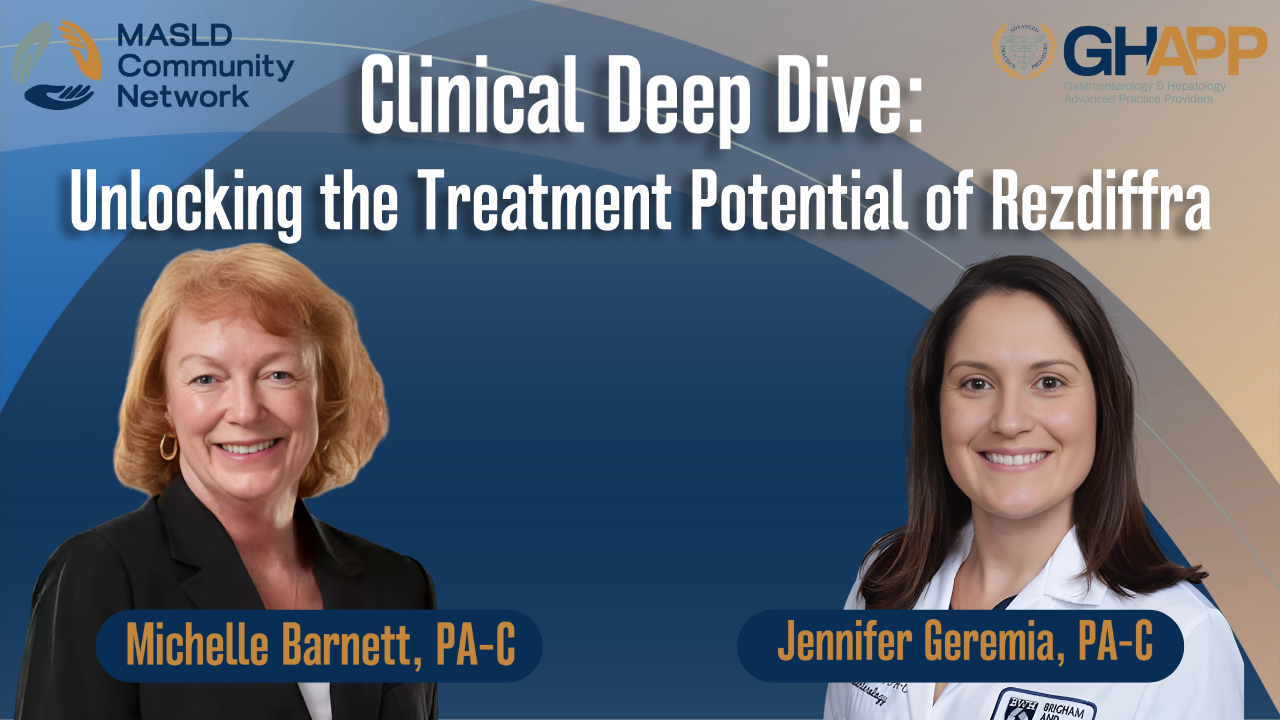
Clinical Deep Dive: Unlocking the Treatment Potential of Rezdiffra
This educational discussion dives into Rezdiffra, the first and only FDA-approved therapy for non-cirrhotic metabolic-associated steatohepatitis (MASH) with moderate to advanced fibrosis. The talk provides a clinical deep dive into the progression of MASH and fibrosis, highlighting the risks of untreated disease and the importance of early intervention. A key focus is the thyroid hormone receptor beta mechanism, explaining how Rezdiffra directly targets liver-specific pathways to reduce hepatic fat accumulation and fibrosis. Additionally, the discussion covers the rigorous FDA approval process and dual efficacy endpoints, detailing how Rezdiffra achieved significant fibrosis improvement and steatohepatitis resolution in the MAESTRO-NASH trial. The session also provides practical insights into patient access, prescribing considerations, and managing common side effects. With over 2,000 patients studied, Rezdiffra has demonstrated a strong safety profile and offers a once-daily oral treatment option that represents a major advancement in MASH management. This discussion is essential for gastroenterologists, hepatologists, and endocrinologists managing patients with MASH, as well as primary care providers and cardiologists who play a role in identifying at-risk individuals. If you are a healthcare professional looking to stay updated on the latest MASH research and treatment strategies, this session provides the insights you need.
Watch Now
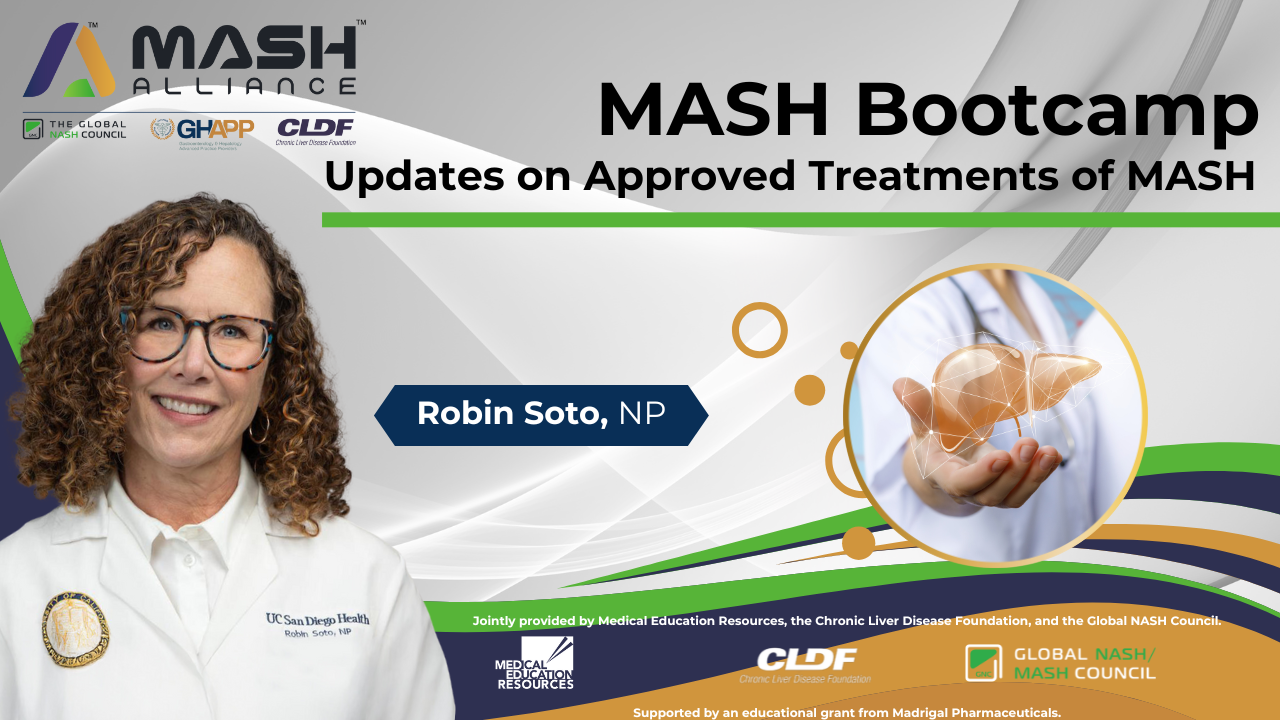
Updates On Approved Treatments for MASH
Join Robin Soto, NP, for an engaging session at the MASH Boot Camp during the 2024 GHAPP National Conference as she provides updates on improved treatments for metabolic-associated steatohepatitis (MASH). Robin dives into the mechanisms of action, key clinical data, and prescribing guidelines for current therapies, including groundbreaking updates from the MAESTRO-NASH study. She also explores the game-changing potential of FDA-approved therapies like Resmetirom, offering insights into its efficacy, safety, and impact on patients with at-risk fibrosis.
Watch Now
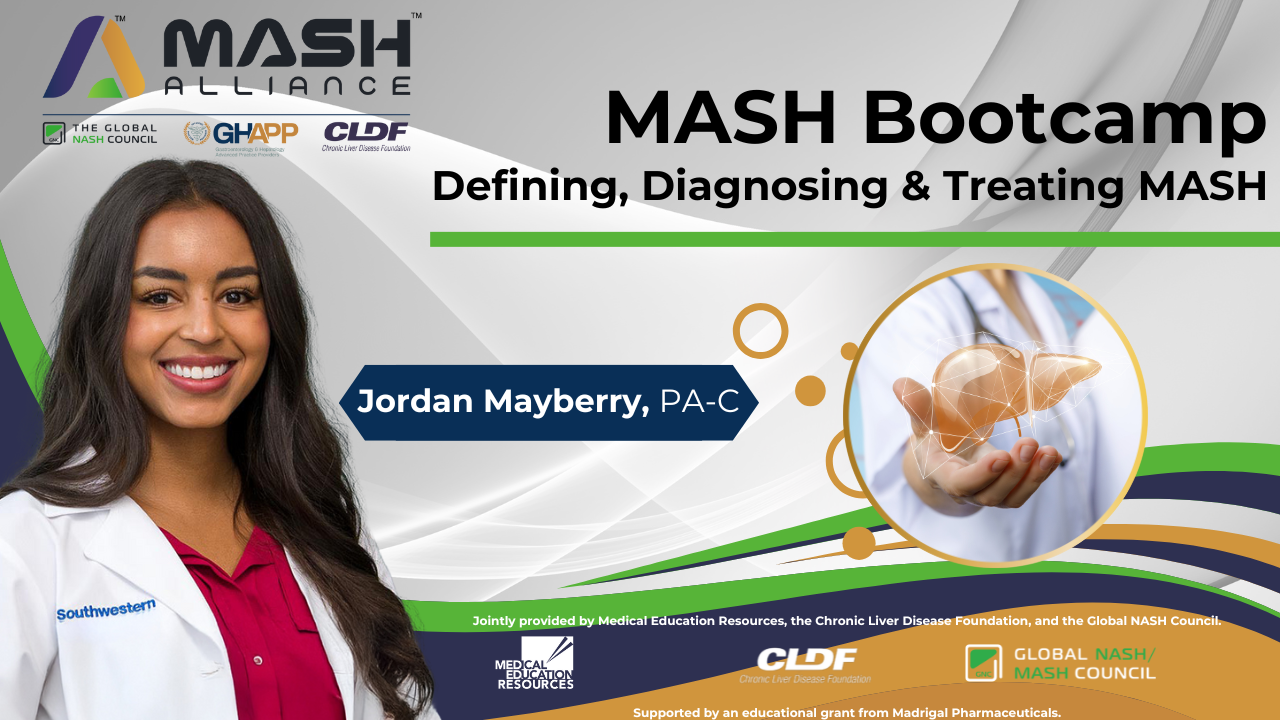
Defining, Diagnosing, & Treating MASH
Join Jordan Mayberry, PA-C, for an insightful video from the MASH Boot Camp at the 2024 GHAPP National Conference. Jordan covers the latest advancements in diagnosing metabolic-associated steatohepatitis (MASH). She provides a comprehensive overview of the evolution of MASH terminology, the diagnostic criteria, and the critical role of patient history in identifying steatosis. Discover how metabolic risk factors, genetic predispositions, and alcohol consumption influence disease progression. Jordan also explores the importance of non-invasive diagnostic tools, when to consider liver biopsies, and how to differentiate MASH from other liver conditions. Perfect for healthcare professionals seeking to refine their approach to liver disease management.
Watch Now

Management of Life Style Modification
This video focuses on the comprehensive management of patients with metabolic-associated steatohepatitis (MASH), emphasizing lifestyle modifications, dietary adjustments, and exercise strategies. Key topics include the importance of addressing risk factors like diet, exercise habits, and alcohol intake, as well as referrals to medically supervised weight loss clinics or bariatric surgery for advanced cases. The speaker highlights the benefits of the Mediterranean diet, intermittent fasting, and avoiding ultra-processed foods while discussing the role of resistance training to combat sarcopenia and maintain muscle mass. Practical advice and tailored recommendations ensure a holistic approach to managing MASH and improving patient outcomes.
Watch Now

Third Step of Life Style Management
This video provides a comprehensive overview of emerging pharmacologic treatments for metabolic-associated steatohepatitis (MASH) and their tailored applications based on patient profiles. Topics include FDA-approved therapies, drugs in advanced clinical trials (such as semaglutide and lanifibranor), and the potential for combination treatments targeting both steatohepatitis and fibrosis. The speaker emphasizes the importance of patient-specific approaches considering metabolic profiles, obesity, and diabetes status, alongside lifestyle interventions. Additionally, the video discusses the evolving interdisciplinary care model and highlights the exciting progress in non-invasive testing and treatment advancements for F2-F3 fibrosis.
Watch Now
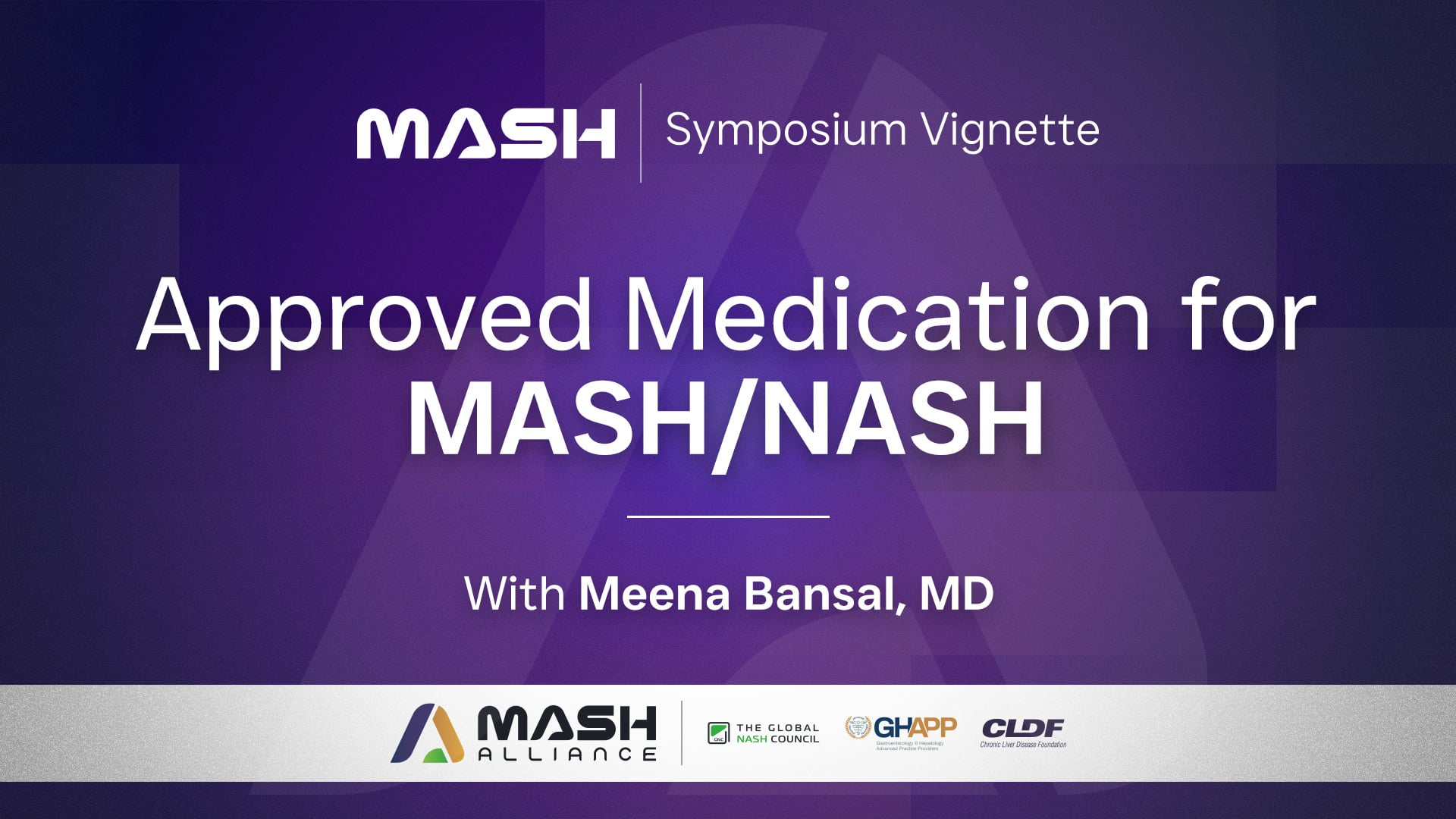
Approved Medication for MASH/NASH
This video provides detailed guidance on selecting and monitoring patients for emerging therapies targeting advanced fibrosis (F2-F3) in NASH. Key topics include contraindications for patients with cirrhosis, considerations for concomitant medications, and dose adjustments for statins. The video outlines ideal candidates based on specific thresholds for VCTE, MRE, ELF scores, and other non-invasive tests while emphasizing the importance of ruling out portal hypertension and other liver diseases. It also reviews a stepwise monitoring approach, focusing on tolerability at three months and efficacy assessments at six and twelve months, with an emphasis on histologic and non-invasive test improvements.
Watch Now
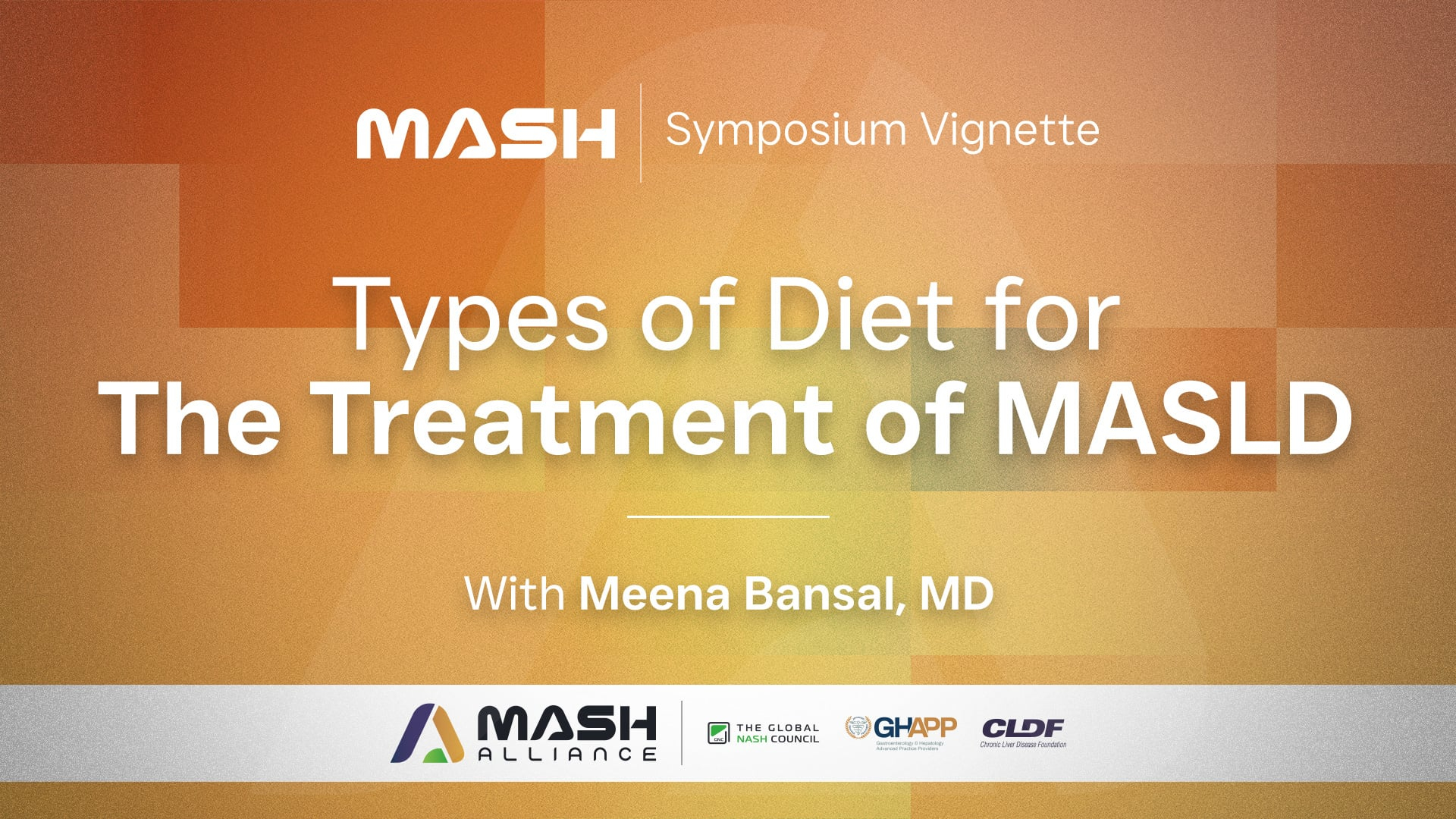
Types of Diet for the Treatment of MASLD
This video explores comprehensive strategies for managing metabolic-associated steatohepatitis (MASH), focusing on fibrosis risk stratification, lifestyle modifications, and pharmacologic interventions. Learn about dietary recommendations like the Mediterranean diet, exercise guidelines emphasizing resistance training, and the role of intermittent fasting and processed food avoidance. The video also highlights weight loss targets, diabetes management, and emerging therapies such as GLP-1 receptor agonists and bariatric surgery, all aimed at improving liver health and patient outcomes.
Watch Now
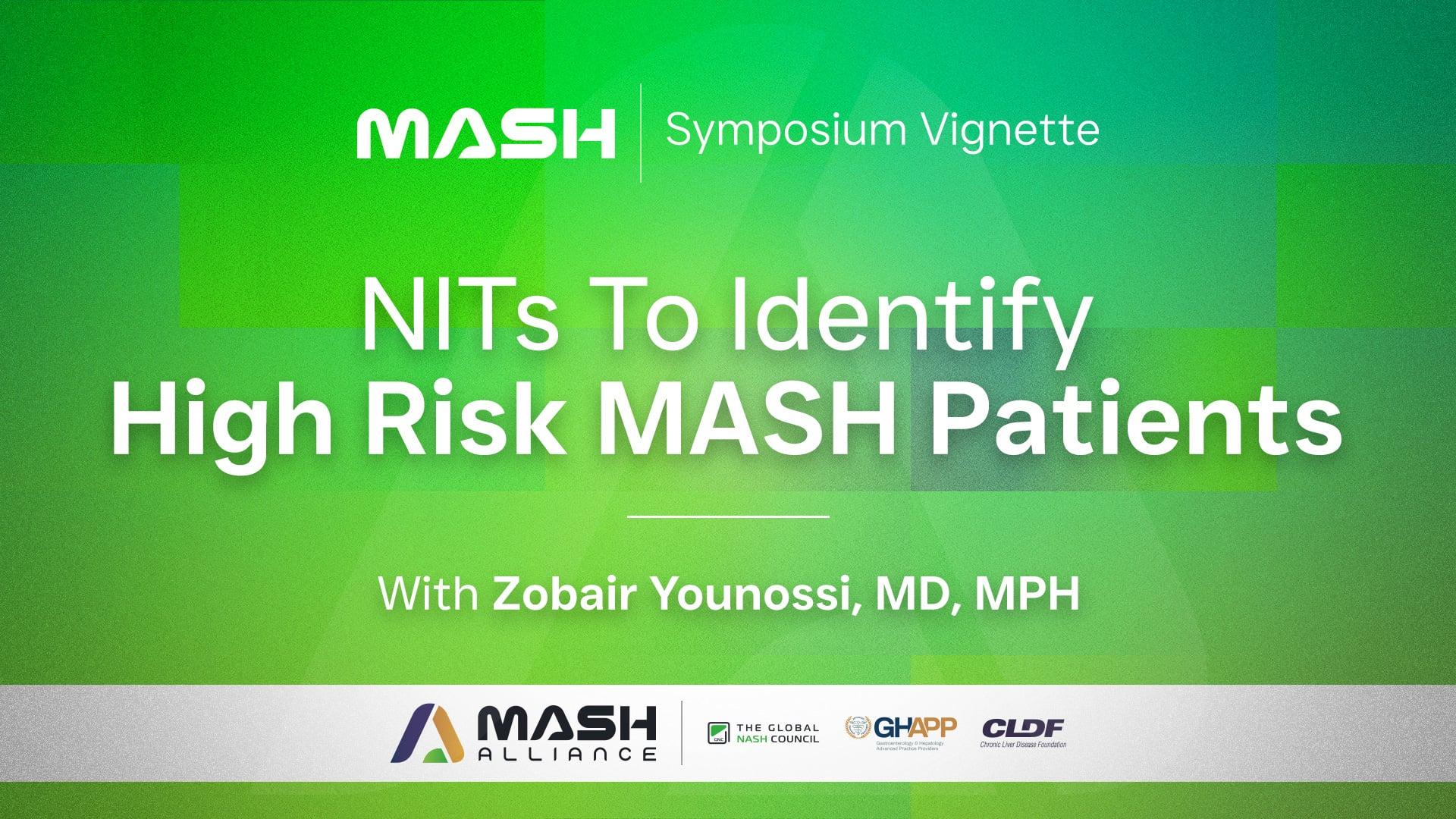
NITs to Identify High Risk MASH Patients
Explore advancements in non-invasive diagnostics and risk stratification for liver fibrosis and MASH. This video highlights tools like FIB-4, transient elastography, and innovative scoring systems (e.g., FAST and Agile) to identify and predict outcomes for high-risk patients. Learn about serum biomarkers, updated guidelines, and the role of lifestyle interventions alongside targeted therapies for managing metabolic risks and advancing care in hepatology.
Watch Now
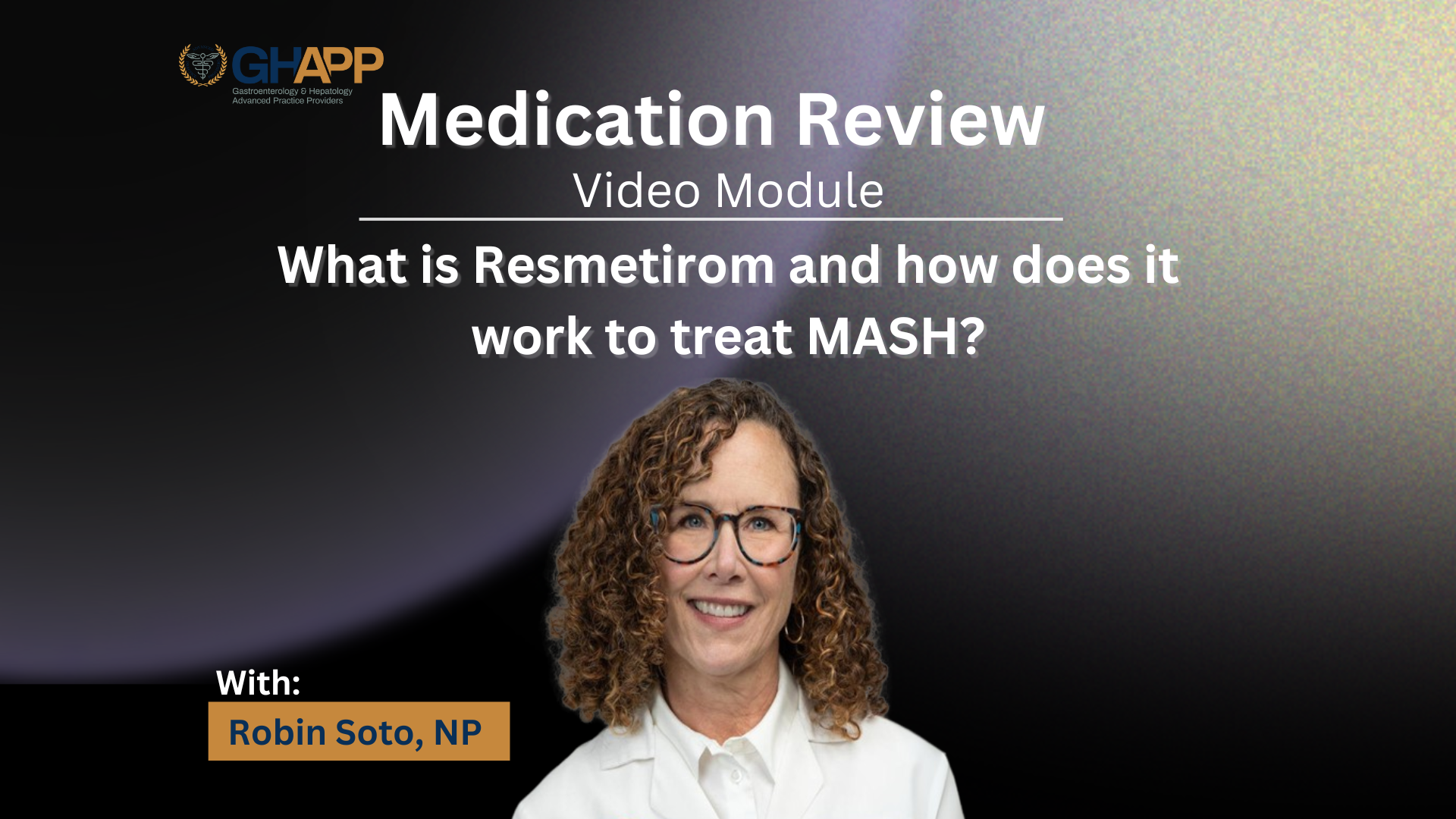
What is Resmetirom and how does it work to treat MASH?
Thank you to Madrigal for sponsoring the Medication Review Video Module. In this GHAPP Medication Review video, Robin Soto, a board-certified nurse practitioner at UC San Diego Health Hepatology, explains the mechanism of action of Resmetirom, the first and only FDA-approved drug for the treatment of MASH in adults with mild to moderate fibrosis (F2-F3). Robin describes how Resmetirom, a liver-directed, thyroid hormone receptor beta agonist, targets liver fat accumulation, promoting fatty acid oxidation and improving cholesterol metabolism. She highlights its anti-inflammatory effects and ability to reduce liver fibrosis by selectively activating receptors in the liver, while minimizing systemic side effects. For more information, visit the GHAPP website and ACE app.
Watch Now
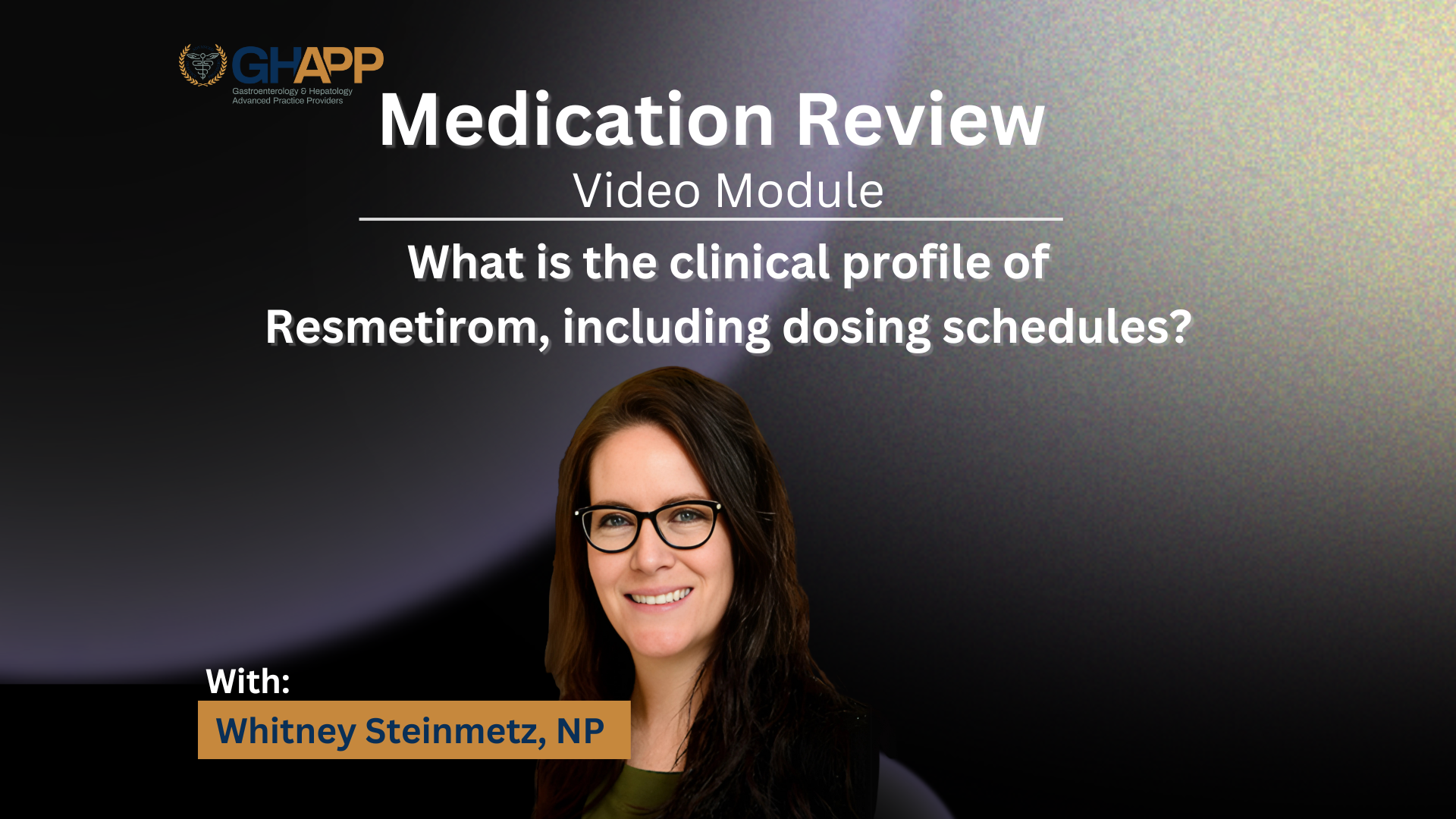
What is the clinical profile of Resmetirom, including dosing schedules?
Thank you to Madrigal for sponsoring this Medication Review Video Module! In this GHAPP Medication Review Video Module, nurse practitioner Whitney Steinmetz discusses the clinical profile of Resmetirom, a thyroid hormone receptor beta agonist indicated for adults with metabolic-associated steatohepatitis (MASH) and moderate to advanced liver fibrosis. Whitney explores the mechanism of action, dosage recommendations, and the dual primary endpoint success of Resmetirom in clinical trials. She highlights key considerations, including drug interactions and common side effects such as nausea and diarrhea, and how they are generally well-tolerated over time. Learn more about Resmetirom's impact on liver health and patient care by visiting the GHAPP website or app.
Watch Now

How is MASH severity staged? What would an ideal MASH NIT algorithm look like?
Thank you to Madrigal for sponsoring this FAQ Video Module. In this GHAPP FAQ Video Module, Jonathan Yeh, a physician assistant at the Center for Liver Disease and Transplantation at Columbia University Irving Medical Center, discusses advancements in diagnosing and staging metabolic dysfunction-associated steatohepatitis (MASH). He explains the transition from traditional liver biopsy to non-invasive testing methods such as FibroScan and the Enhanced Liver Fibrosis (ELF) test for assessing fibrosis stages. Jonathan highlights the use of these methods, in combination with blood tests, to provide reliable staging of fibrosis in patients with MASH. For more information, visit the GHAPP website or ACE app.
Watch Now

A Phase 3, Randomized, Controlled Trial of Resmetirom in MASH with Liver Fibrosis
Thank you to Madrigal for sponsoring this Journal Club Video Module! In this GHAPP Journal Club review, Lisa Richards, a board-certified family nurse practitioner specializing in hepatology at UC San Diego Health, presents pivotal research from a February 2024 New England Journal of Medicine publication. The phase 3 randomized controlled trial evaluated the efficacy of Resmetirom, the first FDA-approved therapy for non-alcoholic steatohepatitis (NASH) with moderate to advanced liver fibrosis. Lisa discusses key findings from the study, including improvements in liver fibrosis and NASH resolution in patients treated with Resmetirom compared to placebo. Join her for an in-depth look at this groundbreaking therapy and its impact on patient care.
Watch Now
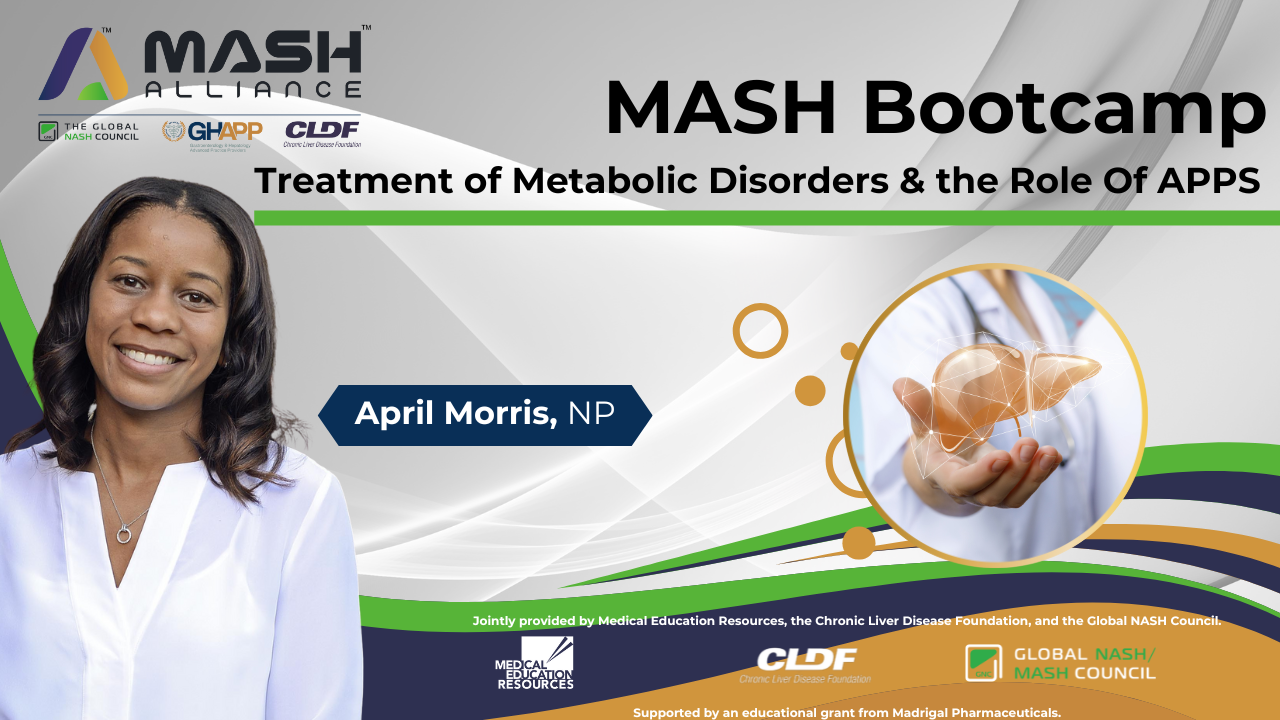
Treatment of Metabolic Disorders and the Role of APPs in MASH
In this video, April Morris, NP, a specialist in hepatology and endocrinology, discusses the comprehensive management of metabolic syndrome and the critical role of advanced practice providers (APPs) in optimizing patient care. With a multidisciplinary approach, she highlights the importance of weight management, medication selection, and addressing comorbidities such as hypertension, hyperlipidemia, and diabetes to improve metabolic-associated steatohepatitis (MASH) and overall health outcomes. April explores various weight loss medications, including GLP-1 receptor agonists and older alternatives, while emphasizing the need for personalized treatment plans that consider insurance coverage and patient history. She also discusses obesogenic medications that contribute to weight gain and suggests safer alternatives that are weight-neutral or promote weight loss. Managing comorbidities is another key focus, as she explains the importance of blood pressure, cholesterol, and diabetes control in reducing cardiovascular risks. Additionally, she stresses the impact of lifestyle modifications, including diet, exercise, and behavioral interventions, for long-term success. Throughout the discussion, April provides clinical insights into medication-induced weight gain, the barriers to accessing newer treatments, and why collaborative care across specialties, including primary care, endocrinology, hepatology, and bariatric surgery, is essential for effective disease management. For more expert insights, visit RhAPP.org and explore the RhAPP ACE 2.0 App for the latest digital education in metabolic and rheumatologic care.
Watch Now

MASH Bootcamp Q&A
In this interactive Q&A session, a panel of liver disease experts discusses key challenges in diagnosing and treating metabolic dysfunction-associated steatohepatitis (MASH) using non-invasive testing and the latest therapeutic advancements. The panel explores the role of FibroScan, ELF scores, and cardiometabolic risk factors in diagnosing fibrosis, especially in patients with limited access to MRI or VCTE-based assessments. They also discuss how serologic testing can be a viable alternative in resource-limited settings and when a liver biopsy may not be necessary for diagnosis. The discussion highlights the FDA approval criteria for Resmetirom, its limitations in F4 patients, and practical strategies for determining treatment eligibility. The experts address real-world challenges, including diagnosing MASH in rural areas, evaluating confounding factors in fibrosis assessment, and ensuring comprehensive liver disease workups to rule out autoimmune conditions.
Watch Now
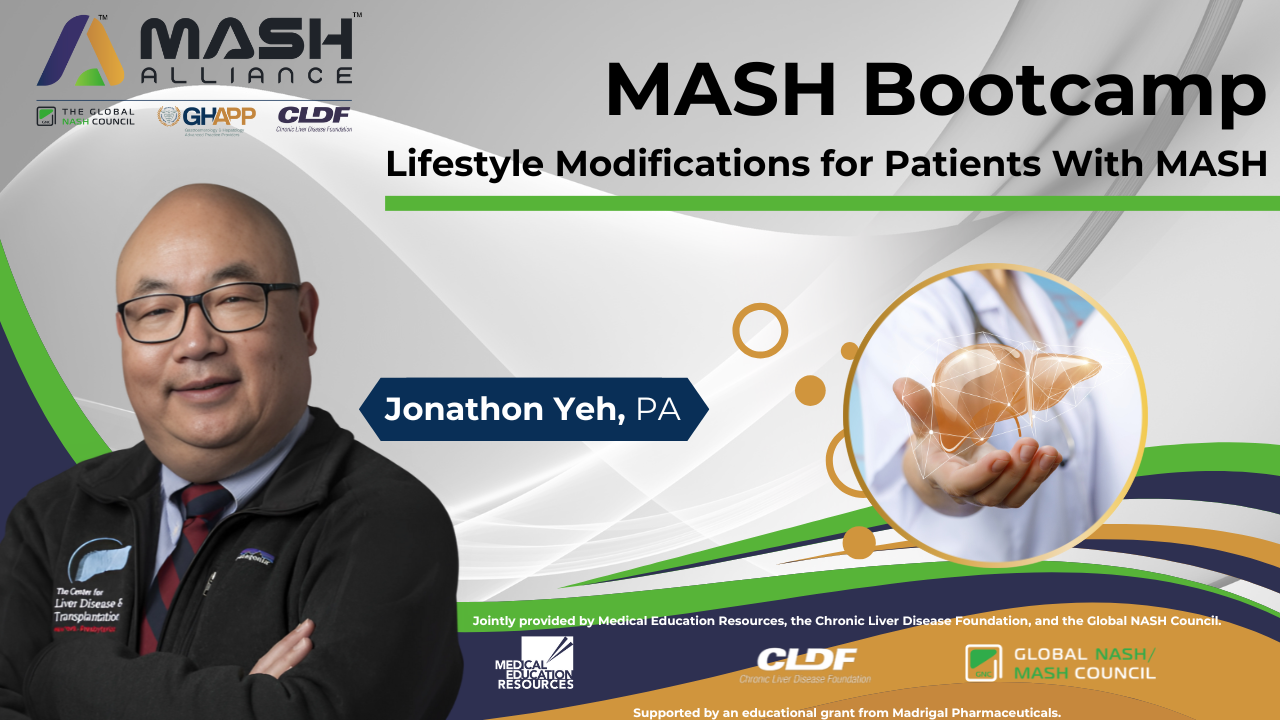
Lifestyle Modifications for Patients With MASH
In this engaging presentation, Jonathan Yeh, PA, from the Center for Liver Disease and Transplantation at Columbia University, explores the critical role of lifestyle modifications in managing metabolic dysfunction-associated steatohepatitis (MASH). He breaks down the pathogenesis of MASH, explaining how obesity, diabetes, and metabolic dysfunction drive disease progression from steatosis to fibrosis and cirrhosis, and why weight loss and exercise are essential for reversing liver damage. Jonathan highlights the impact of dietary interventions, including the Mediterranean diet, low-carb approaches, and ketogenesis, while emphasizing the importance of calorie restriction over simply eliminating certain food groups. He also discusses the role of exercise, comparing the effectiveness of aerobic training, resistance training, and high-intensity interval training (HIIT) for improving liver health. Surprisingly, research suggests that resistance training may be just as beneficial as aerobic exercise while being more accessible to patients with physical limitations. The discussion also touches on the latest weight loss treatments, including GLP-1 receptor agonists like semaglutide and tirzepatide, which are rapidly transforming obesity management. However, Jonathan underscores that medications alone are not a solution—sustainable lifestyle changes remain the foundation of MASH treatment.
Watch Now
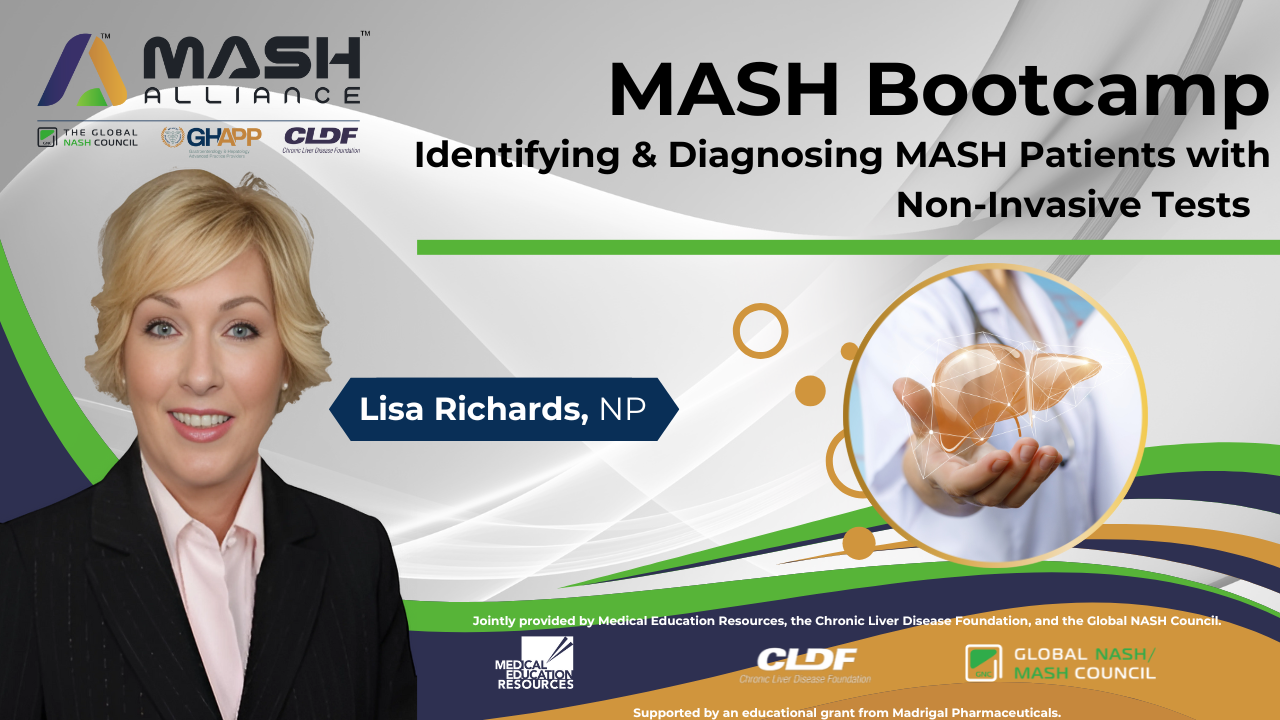
Identifying & Diagnosing MASH Patients with Non-Invasive Tests
In this informative session, Lisa Richards, NP, a hepatology expert from UC San Diego Healthcare, explores how non-invasive tests (NITs) can effectively diagnose metabolic dysfunction-associated steatohepatitis (MASH) and fibrosis without the need for a liver biopsy. She discusses the role of imaging and blood-based biomarkers, such as FibroScan, MRE, ELF, and FIB-4, in identifying patients with stage 2 or higher liver fibrosis and highlights their clinical applications in real-world settings. Lisa walks through a detailed case study, demonstrating how to interpret non-invasive test results, assess risk stratification, and make confident diagnostic decisions using combined NITs like FAST, MEFIB, and MAST scores. She also addresses key limitations of FibroScan and MRI elastography, including BMI constraints, insurance coverage challenges, and patient-specific factors like claustrophobia. Additionally, Lisa introduces clinical care pathways from leading hepatology organizations, explaining how primary care providers and specialists can collaborate to monitor and manage at-risk MASH patients. She emphasizes that, with modern non-invasive tools, biopsies are no longer necessary for diagnosing most MASH patients, enabling earlier intervention and improved patient outcomes.
Watch Now
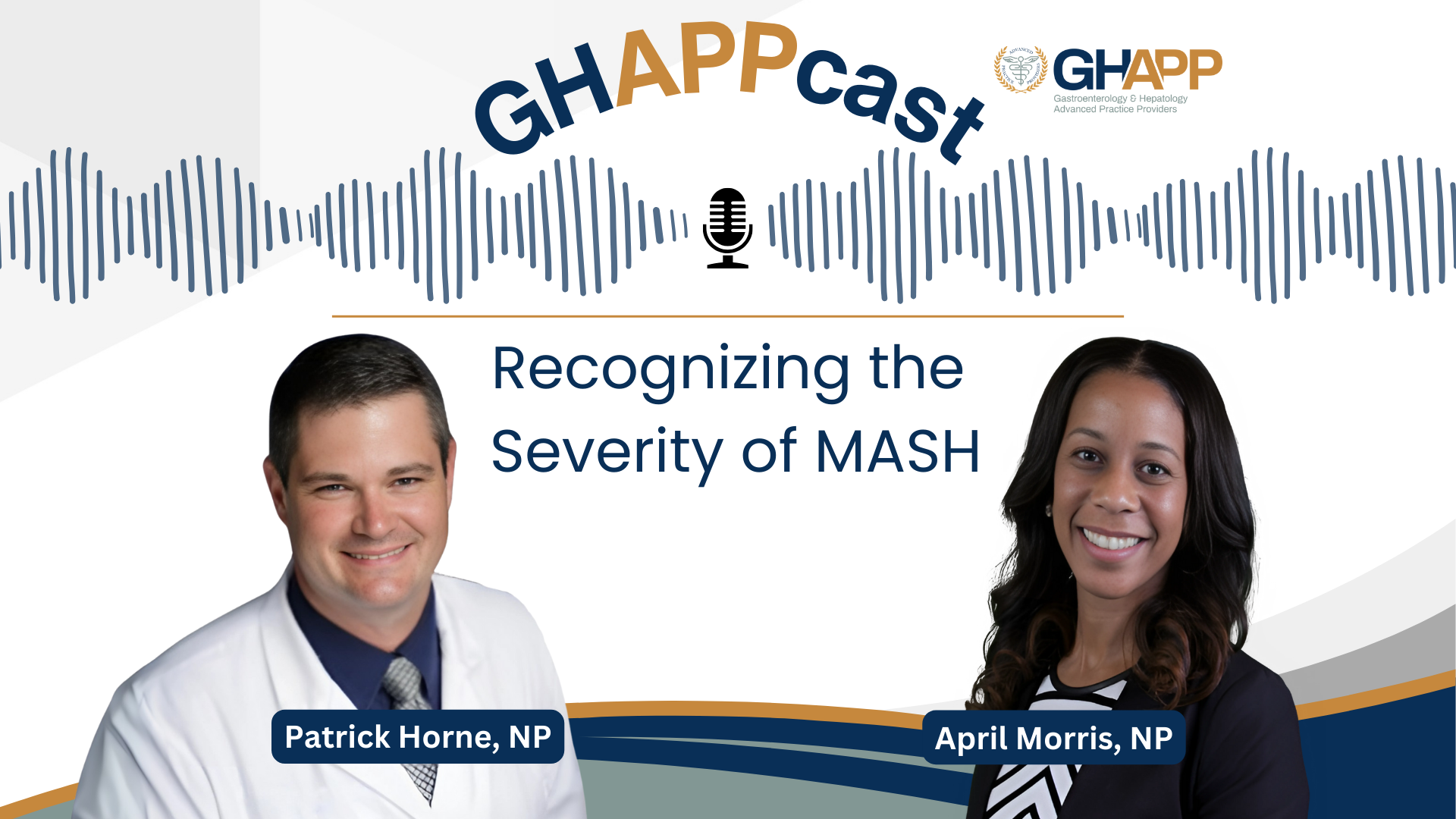
GHAPPcast: Recognizing the Severity of MASH

Thank you to Madrigal for sponsoring this episode of GHAPPcast. In this episode of GHAPPcast, nurse practitioners Patrick Horne and April Morris from discuss the complexities of identifying and managing patients with metabolic-associated steatohepatitis (MASH). They explore clinical approaches, including the use of bloodwork, family history, and advanced diagnostic tools such as FibroScan, to recognize patients at risk. Patrick and April emphasize the importance of lifestyle interventions like diet and exercise alongside new medical therapies, while also offering practical tips for clinicians on patient monitoring and treatment management. Tune in for valuable insights into managing MASH in clinical practice.
Watch Now
Latest News & Blogs
Deep sequencing-derived Metagenome Assembled Genomes from the gut microbiome of liver transplant patients
Recurrence of metabolic dysfunction-associated steatotic liver disease (MASLD) after liver transplantation (LT) is a continuing concern. The role of gut microbiome dysbiosis in MASLD initiation and progression has been well established. However, there is a lack of comprehensive gut microbiome shotgun sequence data for patients experiencing MASLD recurrence after LT. In this data descriptor, we describe a dataset of deep metagenomic sequences of a well-defined LT recipient population....
Read More
Treatment of rapid recurrence of severe steatosis with combined GLP-1 agonist and growth hormone therapy in a pediatric patient transplanted for metabolic dysfunction-associated steatohepatitis cirrhosis in the setting of hypopituitarism
The association between hypopituitarism and metabolic dysfunction-associated steatotic liver disease (MASLD) is increasingly recognized, although data about therapies targeting recurrence post-transplant is limited. An 8-year-old with hypopituitarism-associated MASLD underwent a liver transplant due to rapid progression of metabolic dysfunction-associated steatohepatitis (MASH). Hepatosteatosis recurred within weeks. Her therapeutic plan included a glucagon-like peptide-1 agonist (GLP-1a) and...
Read More
Ubiquitination of TFEB increased intestinal permeability to aggravate metabolic dysfunction-associated steatohepatitis
CONCLUSIONS: The ubiquitination of TFEB plays a pivotal role in increasing intestinal permeability and promoting the progression of MASH by inhibiting autophagy. Intestinal TFEB may represent a novel therapeutic target for the treatment of MASH.
Read More
Pan-PPAR agonist lanifibranor improves insulin resistance and hepatic steatosis in patients with T2D and MASLD
CONCLUSIONS: Lanifibranor significantly improves hepatic, muscle and adipose tissue insulin resistance. Lanifibranor treatment was safe and effective in reducing hepatic steatosis and cardiometabolic risk factors associated with metabolic dysfunction.
Read More
Estimated Burden of Metabolic Dysfunction-Associated Steatotic Liver Disease in US Adults, 2020 to 2050
CONCLUSIONS AND RELEVANCE: In this decision analytical modeling study, the model forecast a substantial increase in clinical burden of MASLD over the next 3 decades in the absence of effective treatments. These results suggest that health systems should plan for large increases in the number of HCC cases and in the need for LT.
Read More
Cardiovascular Risk Reduction in Metabolic Dysfunction-Associated Steatotic Liver Disease and Metabolic Dysfunction-Associated Steatohepatitis
PURPOSE OF REVIEW: Metabolic dysfunction-associated steatotic liver disease (MASLD) is the most common chronic liver disease, characterized by hepatic steatosis with at least one cardiometabolic risk factor. Patients with MASLD are at increased risk for the occurrence of cardiovascular events. Within this review article, we aimed to provide an update on the pathophysiology of MASLD, its interplay with cardiovascular disease, and current treatment strategies.
Read More
Testimonial







